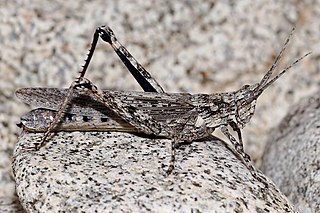
Acrididae, commonly called short-horned grasshoppers, are the predominant family of grasshoppers, comprising some 10,000 of the 11,000 species of the entire suborder Caelifera. The Acrididae are best known because all locusts are of the Acrididae. The subfamily Oedipodinae is sometimes classified as a distinct family Oedipodidae in the superfamily Acridoidea. Acrididae grasshoppers are characterized by relatively short and stout antennae, and tympana on the side of the first abdominal segment.
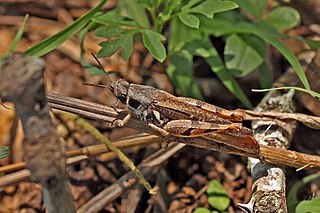
The subfamily Catantopinae is a group of insects classified under family Acrididae. Genera such as Macrotona may sometimes called "spur-throated grasshoppers", but that name is also used for grasshoppers from other subfamilies, including the genus Melanoplus from the Melanoplinae.

Ectobiidae is a family of the order Blattodea (cockroaches). This family contains many of the smaller common household pest cockroaches, among others. They are sometimes called wood cockroaches. A few notable species include:

Bandwings, or band-winged grasshoppers, are the subfamily Oedipodinae of grasshoppers classified under the family Acrididae. They have a worldwide distribution and were originally elevated to full family status as the Oedipodidae. Many species primarily inhabit xeric weedy fields, and some are considered to be important locusts:

The grasshopper subfamily Acridinae, sometimes called silent slant-faced grasshoppers, belong of the large family Acrididae in the Orthoptera: Caelifera.

Chorthippus is a large genus of acridid grasshoppers with around 230 described species. The genus may be subdivided into subgenera including: Altichorthippus, Chorthippus and Glyptobothrus, with other species not placed.
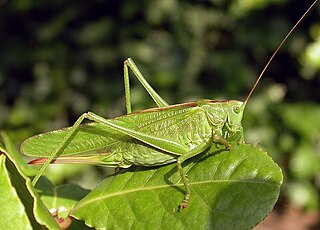
The Tettigoniinae are a subfamily of bush crickets or katydids, which contains hundreds of species in about twelve tribes.

The Phaneropterinae, the sickle-bearing bush crickets or leaf katydids, are a subfamily of insects within the family Tettigoniidae. Nearly 2,060 species in 85 genera throughout the world are known. They are also known as false katydids or round-headed katydids.
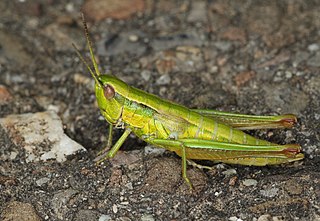
Gomphocerinae, sometimes called "slant-faced grasshoppers", are a subfamily of grasshoppers found on every continent but Antarctica and Australia.
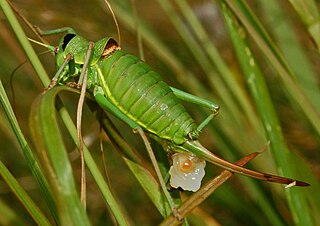
The Bradyporinae are a subfamily in the family Tettigoniidae, based on the type genus Bradyporus. First described as a family, "Bradyporidae", the first use as Bradyporinae was by Brunner von Wattenwyl in 1878.

Pamphagidae is a family of grasshoppers belonging to the superfamily Acridoidea. The species in this family can be found in Africa, Europe and Asia.

Oxyinae is subfamily of grasshoppers in the family Acrididae. Species are distributed throughout Africa and Australasia.

Podismini is a tribe of "spur-throated grasshoppers" in the family Acrididae. This tribe is unlike others in the subfamily Melanoplinae in that genera are found throughout the northern hemisphere, with a substantial number occurring outside the Americas.

The Hemiacridinae are a subfamily of Acrididae in the Orthoptera: Caelifera. Species can be found in Africa and Asia.

Romaleinae is a subfamily of lubber grasshoppers in the family Romaleidae, found in North and South America. More than 60 genera and 260 described species are placed in the Romaleinae.
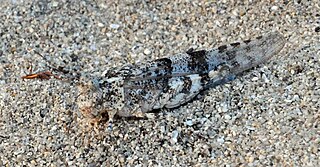
Sphingonotus is a genus of grasshoppers in the family Acrididae, subfamily Oedipodinae, found in Europe Africa, Asia and Australia.

Heteracris is a genus of short-horned grasshoppers in the family Acrididae. There are more than 60 described species in Heteracris, found in Africa, southern Europe, and manland Asia through to India.

The Ommatolampidinae are a subfamily of grasshoppers in the family Acrididae, found in central and South America, and based on the type genus Ommatolampis. Derived from the "Ommatolampides" used by Brunner von Wattenwyl in 1893, the first use of the name in its current form was by Rodríguez et al. in 2013; this taxon appears to be paraphyletic.


















